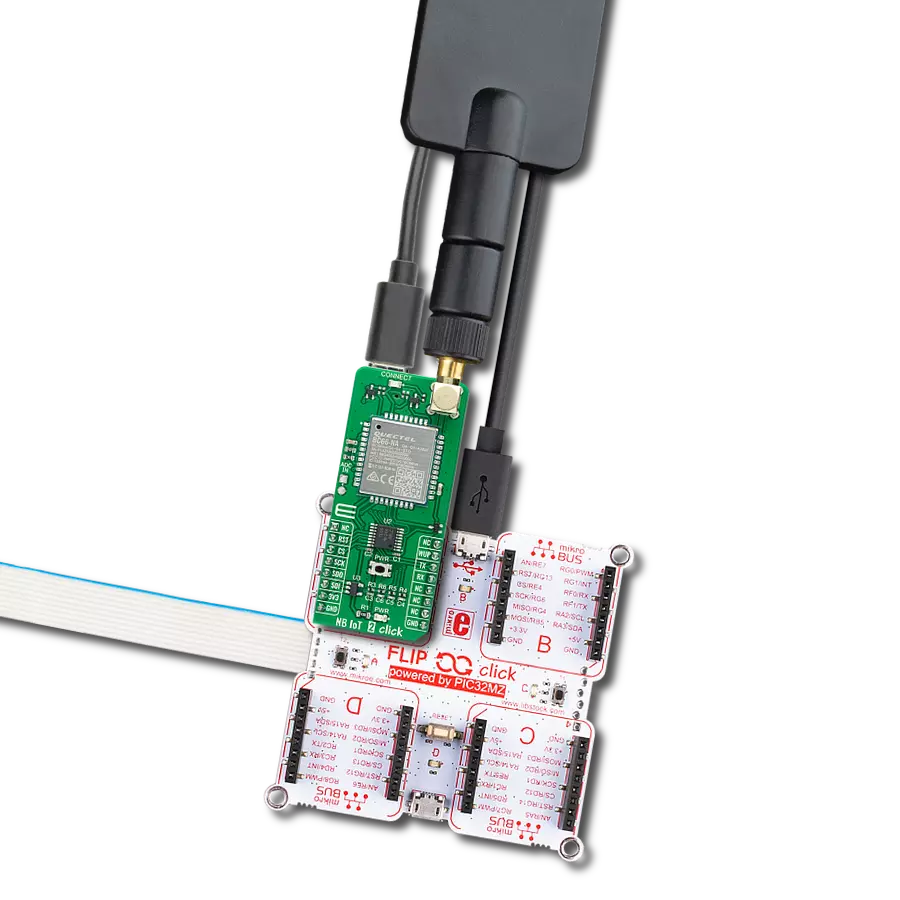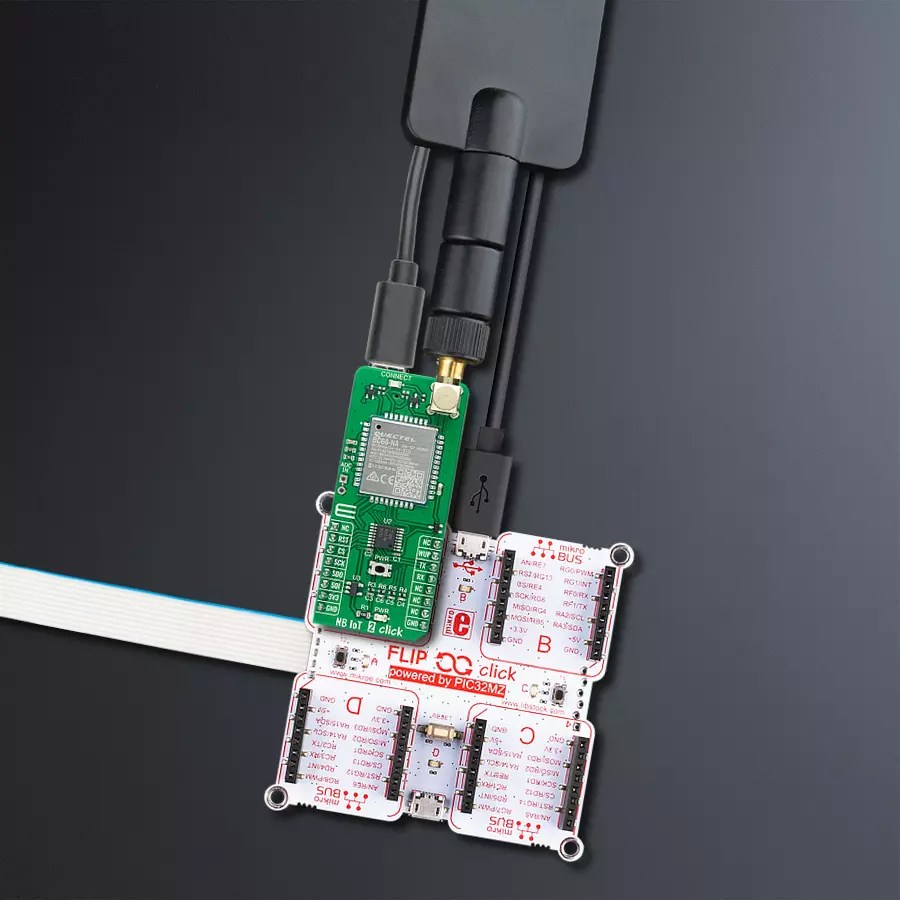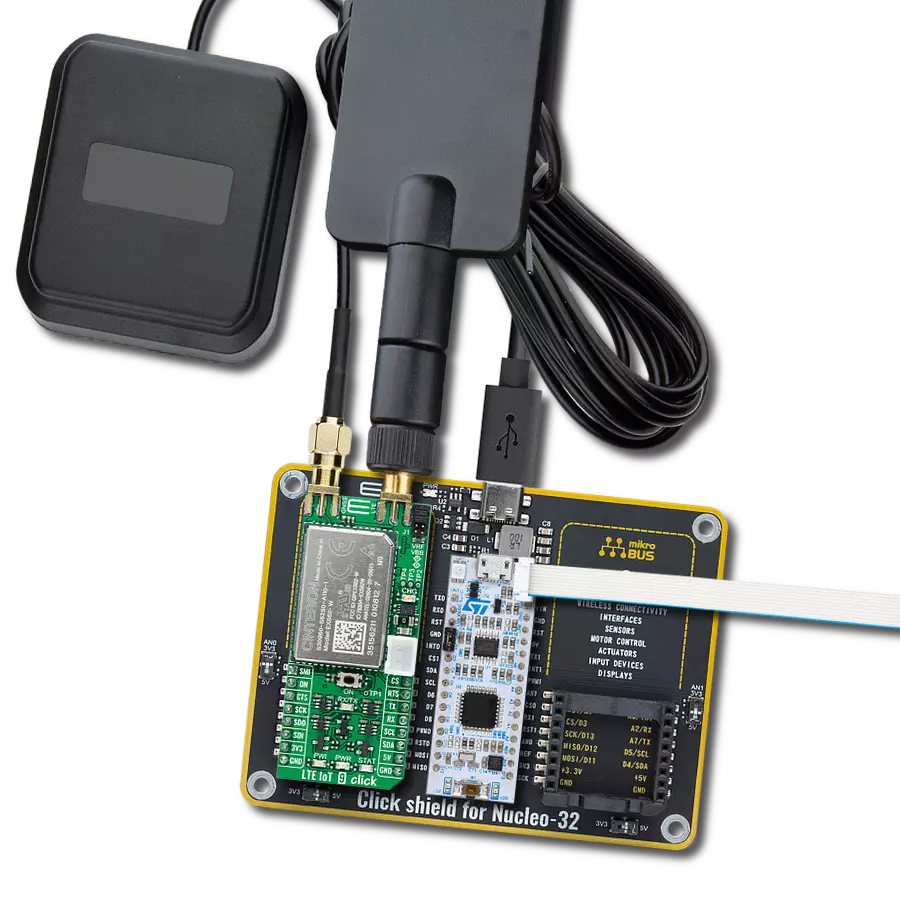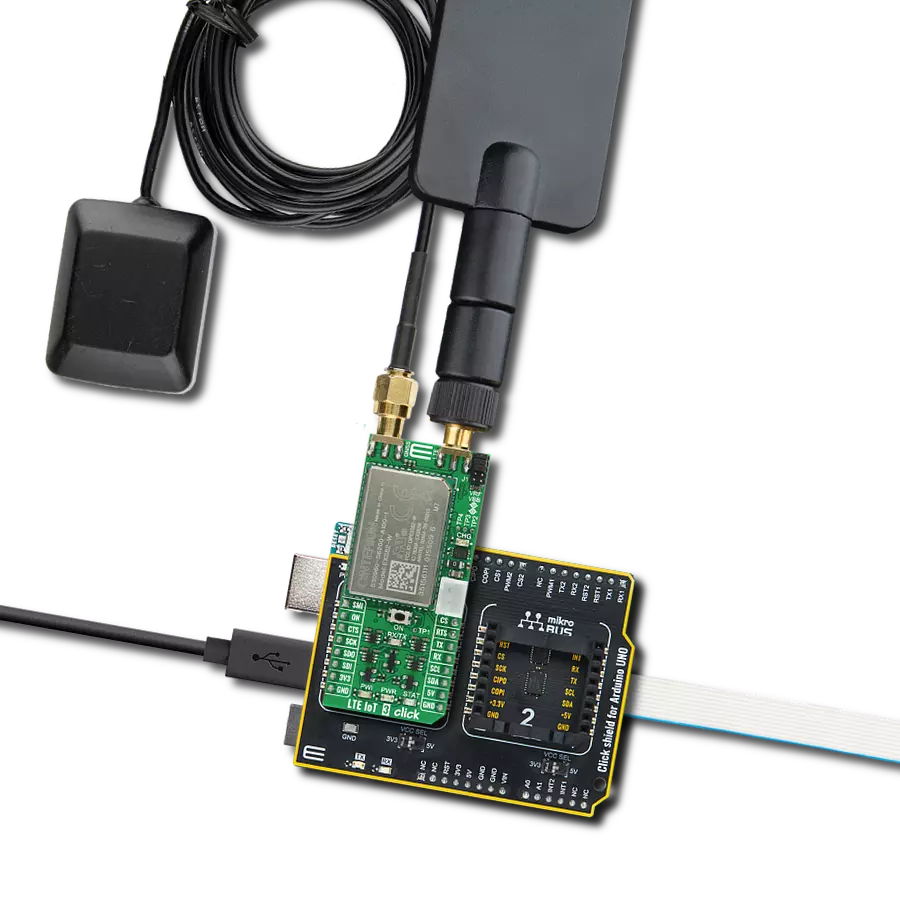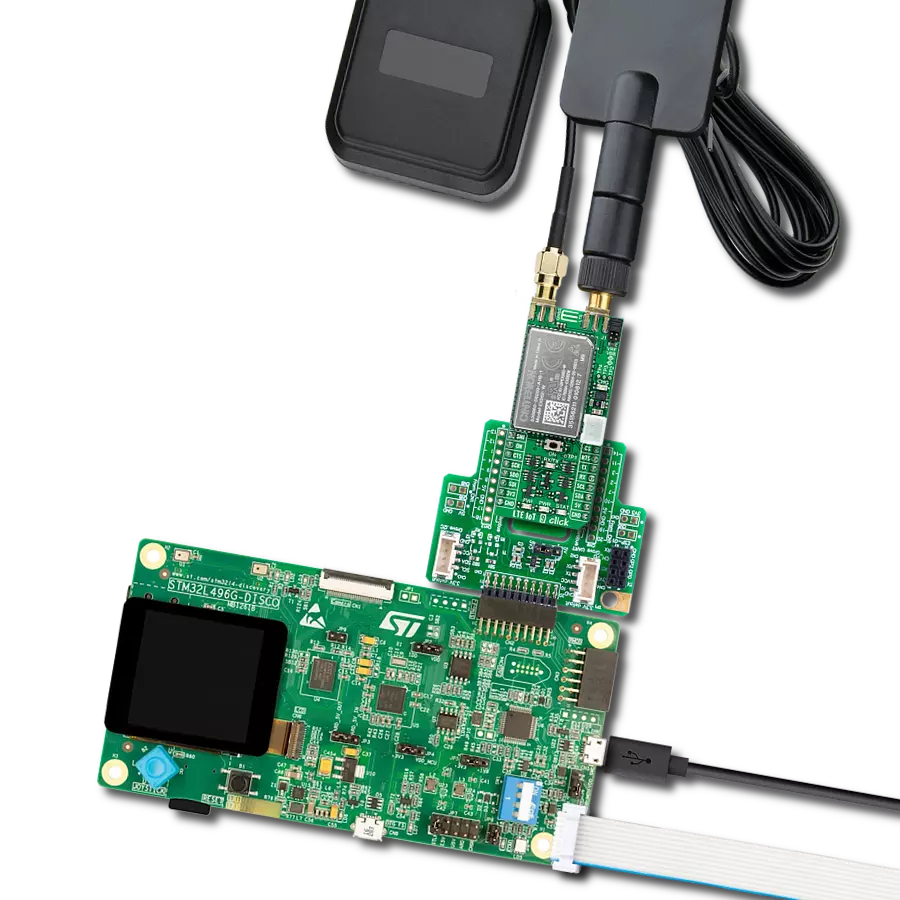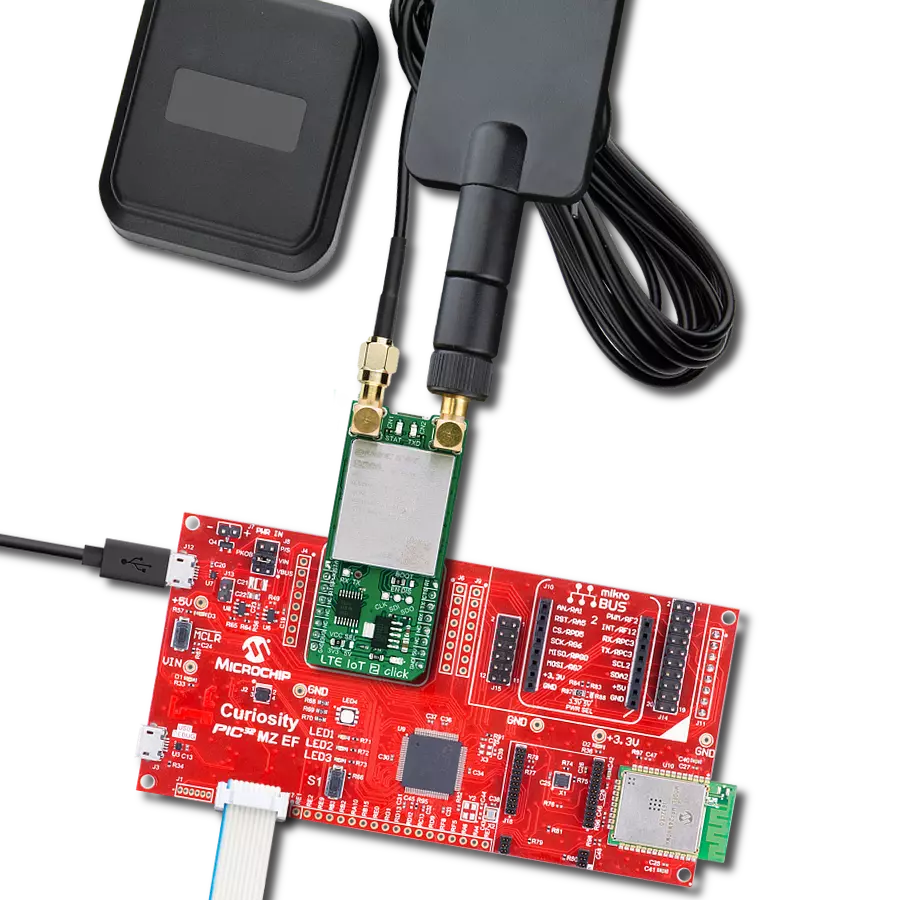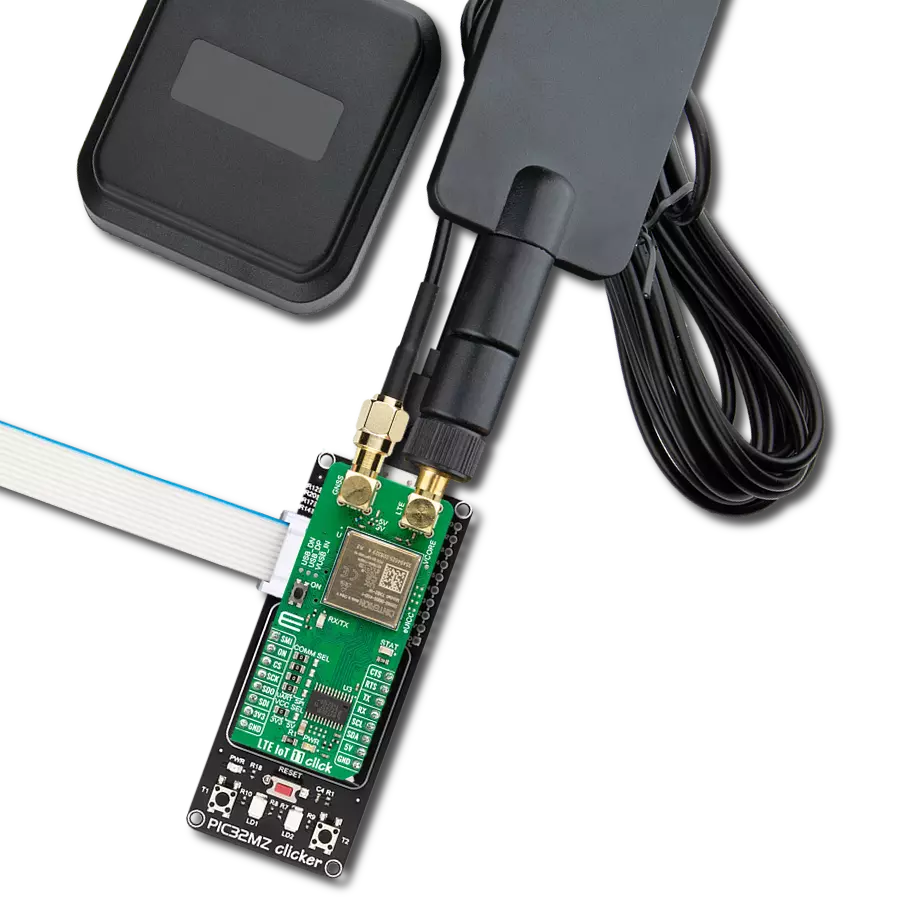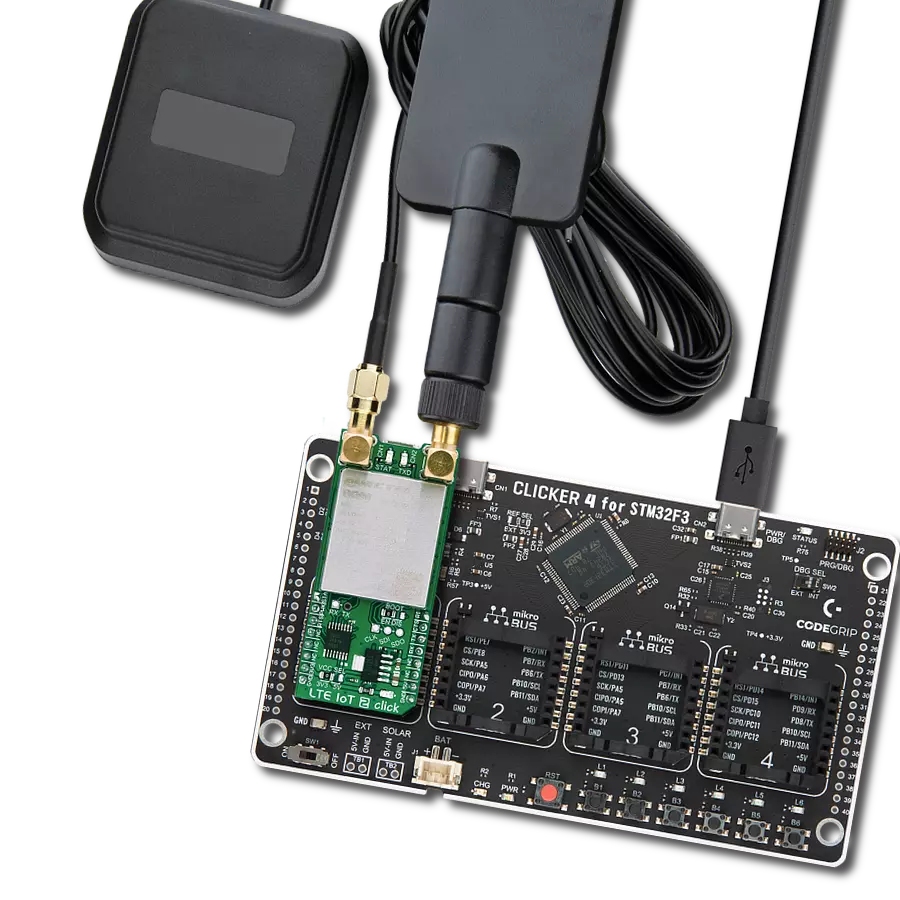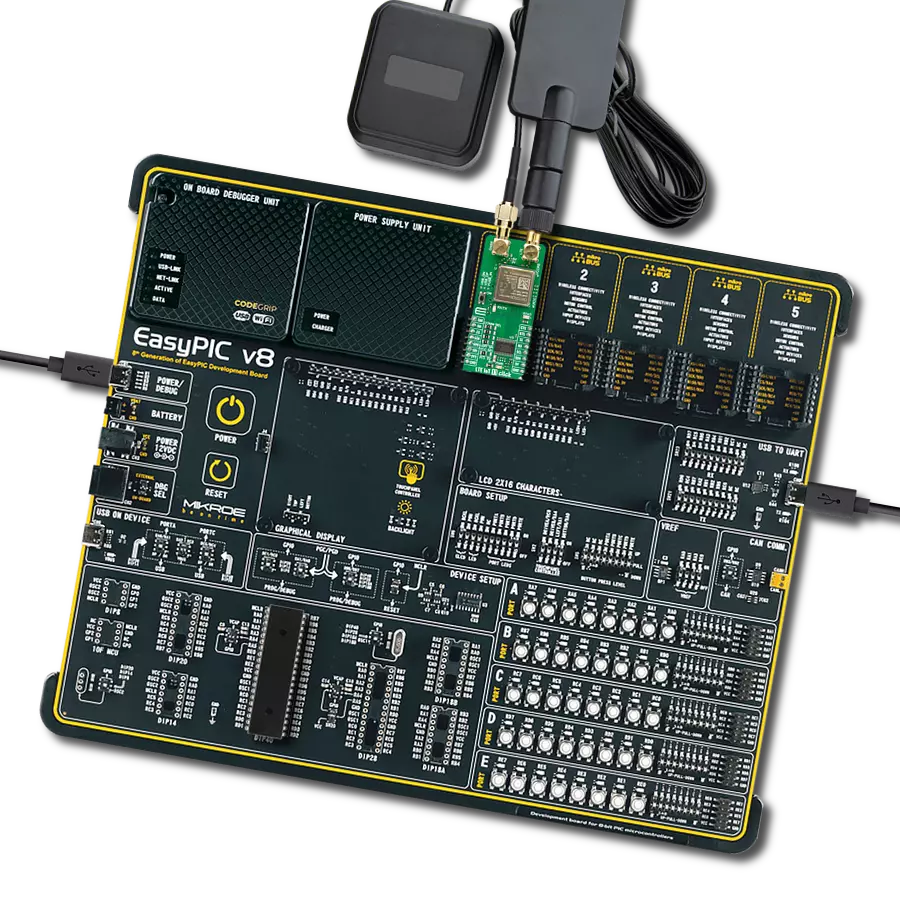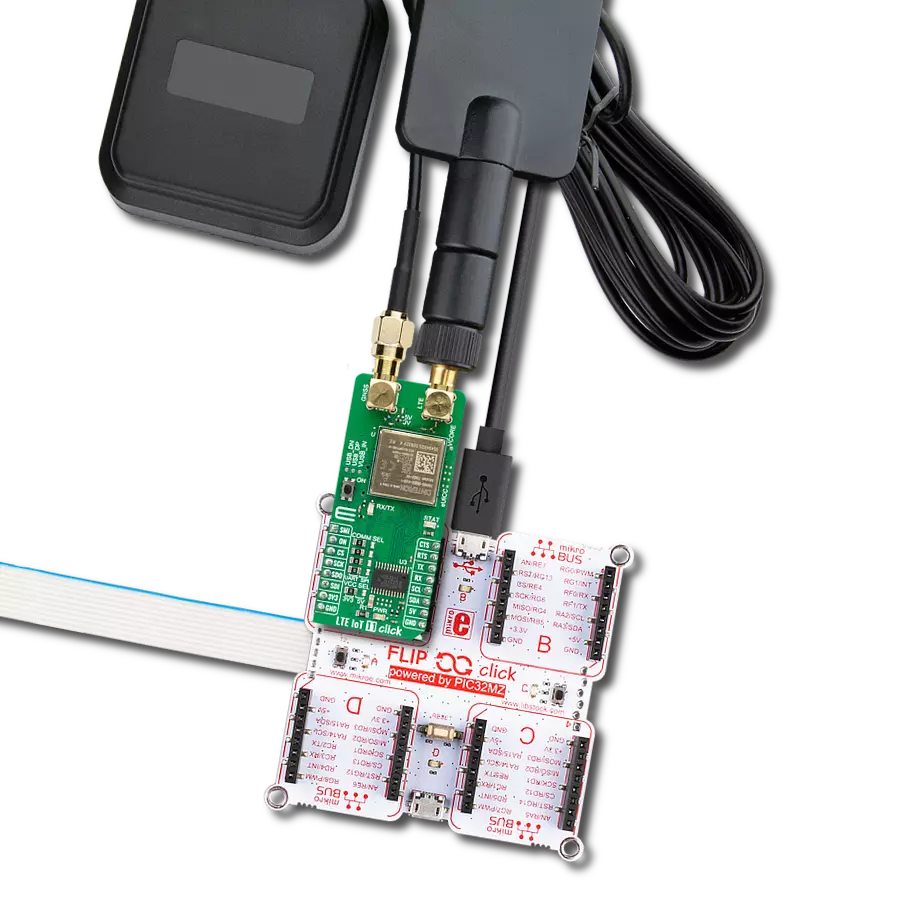Experience IoT in a new light with NB-IoT technology, redefining what's achievable and setting the stage for boundless innovation
A
A
Hardware Overview
How does it work?
NB IoT 2 Click is based on the BC66-NA, a high-performance NB-IoT module with extremely low power consumption from Quectel Wireless Solutions. It is designed to communicate with the infrastructures of mobile network operators through NB-IoT radio protocols (3GPP Rel.13 and 3GPP Rel.14). It supports a broad range of frequency bands such as B1/B2/B3/B4/B5/B8/B12/ B13/B17/B18/B19/B20/B25/B28/B66/B71/B85. It also provides several interfaces, UART and SPI, and protocol stacks such as UDP/TCP, MQTT, LwM2M, and others. These protocols allowing data and SMS transmission using NB technology make this module the perfect choice for building IoT applications such as smart gas and water meters, even without needing an external MCU unit. To turn ON this Click board™, the user has to press the onboard push-button labeled PWRKEY down for a period longer, at least 500ms, which represents the Ignition (Power-On) button. The PWRKEY button cannot be pulled down constantly; otherwise, the module cannot enter
power-save mode. This feature is shown by the yellow diode labeled as CONNECT to indicate the device's Operational Status. NB IoT 2 Click communicates with MCU using the UART interface as its default communication protocol with the option for the users to use another interface, such as SPI if they want to configure the module and write the library by themselves. It supports automatic baud rate detection, operates at 115200 bps by default configuration, and is used for data transmission and exchanging AT commands with the host MCU. In addition to these features, the BC66-NA uses two GPIO pins connected to the mikroBUS™ socket. The WUP pin routed on the INT pin of the mikroBUS™ represents the external interrupt pin used for waking up the device from a power-saving mode, while the RST pin on the mikroBUS™ socket can perform Hardware Reset function by putting this pin in a logic low state. This Click board™ also has a micro USB connector, allowing the module to be powered and configured by a personal computer.
Also, it has an additional header labeled ADC IN because the BC66-NA provides a 10-bit ADC input channel to read the voltage value. The interface is available in Active mode and has to be woken up first to ensure availability in Sleep mode. NB IoT 2 Click possesses the SMA antenna connector with an impedance of 50Ω. This Click board™ can be used to connect the appropriate antenna that MIKROE offers. Besides the SMA connector, it has a SIM card slot that provides multiple connections and interface options. This Click board™ can be operated only with a 3.3V logic voltage level and comes with a proper logic voltage level conversion performed by the appropriate voltage level translator TXB0106. The board must complete the proper logic voltage level conversion before use with MCUs with different logic levels. However, the Click board™ comes equipped with a library containing functions and an example code that can be used as a reference for further development.
Features overview
Development board
Flip&Click PIC32MZ is a compact development board designed as a complete solution that brings the flexibility of add-on Click boards™ to your favorite microcontroller, making it a perfect starter kit for implementing your ideas. It comes with an onboard 32-bit PIC32MZ microcontroller, the PIC32MZ2048EFH100 from Microchip, four mikroBUS™ sockets for Click board™ connectivity, two USB connectors, LED indicators, buttons, debugger/programmer connectors, and two headers compatible with Arduino-UNO pinout. Thanks to innovative manufacturing technology,
it allows you to build gadgets with unique functionalities and features quickly. Each part of the Flip&Click PIC32MZ development kit contains the components necessary for the most efficient operation of the same board. In addition, there is the possibility of choosing the Flip&Click PIC32MZ programming method, using the chipKIT bootloader (Arduino-style development environment) or our USB HID bootloader using mikroC, mikroBasic, and mikroPascal for PIC32. This kit includes a clean and regulated power supply block through the USB Type-C (USB-C) connector. All communication
methods that mikroBUS™ itself supports are on this board, including the well-established mikroBUS™ socket, user-configurable buttons, and LED indicators. Flip&Click PIC32MZ development kit allows you to create a new application in minutes. Natively supported by Mikroe software tools, it covers many aspects of prototyping thanks to a considerable number of different Click boards™ (over a thousand boards), the number of which is growing every day.
Microcontroller Overview
MCU Card / MCU
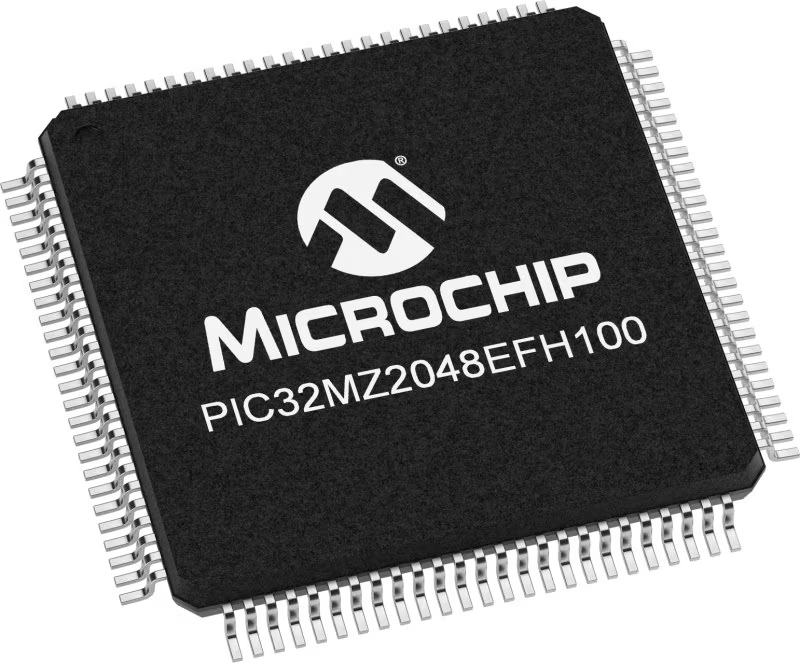
Architecture
PIC32
MCU Memory (KB)
2048
Silicon Vendor
Microchip
Pin count
100
RAM (Bytes)
524288
You complete me!
Accessories
LTE Flat Rotation Antenna is a versatile choice for boosting the performance of 3G/4G LTE devices. With a wide frequency range of 700-2700MHz, it ensures optimal connectivity on major cellular bands worldwide. This flat antenna features an SMA male connector, making it easy to attach directly to your device or SMA module connector. One of its standout features is its adjustable angle, which can be set in 45⁰ increments (0⁰/45⁰/90⁰), allowing you to fine-tune the antenna's orientation for maximum signal reception. With an impedance of 50Ω and a VSW Ratio of <2.0:1, this antenna ensures a reliable and efficient connection. Its 5dB gain, vertical polarization, and omnidirectional radiation pattern enhance signal strength, making it suitable for various applications. Measuring 196mm in length and 38mm in width, this antenna offers a compact yet effective solution for improving your connectivity. With a maximum input power of 50W, it can handle the demands of various devices.
Used MCU Pins
mikroBUS™ mapper
Take a closer look
Click board™ Schematic

Step by step
Project assembly
Track your results in real time
Application Output
1. Application Output - In Debug mode, the 'Application Output' window enables real-time data monitoring, offering direct insight into execution results. Ensure proper data display by configuring the environment correctly using the provided tutorial.

2. UART Terminal - Use the UART Terminal to monitor data transmission via a USB to UART converter, allowing direct communication between the Click board™ and your development system. Configure the baud rate and other serial settings according to your project's requirements to ensure proper functionality. For step-by-step setup instructions, refer to the provided tutorial.

3. Plot Output - The Plot feature offers a powerful way to visualize real-time sensor data, enabling trend analysis, debugging, and comparison of multiple data points. To set it up correctly, follow the provided tutorial, which includes a step-by-step example of using the Plot feature to display Click board™ readings. To use the Plot feature in your code, use the function: plot(*insert_graph_name*, variable_name);. This is a general format, and it is up to the user to replace 'insert_graph_name' with the actual graph name and 'variable_name' with the parameter to be displayed.

Software Support
Library Description
This library contains API for NB IoT 2 Click driver.
Key functions:
nbiot2_set_rst_pin_state- This function sets RST pin statenbiot2_hw_reset- NB IoT 2 hardware reset functionnbiot2_send_cmd- NB IoT 2 send command function
Open Source
Code example
The complete application code and a ready-to-use project are available through the NECTO Studio Package Manager for direct installation in the NECTO Studio. The application code can also be found on the MIKROE GitHub account.
/*!
* @file main.c
* @brief NB IoT 2 Click Example.
*
* # Description
* This example reads and processes data from NB IoT 2 Clicks.
*
* The demo application is composed of two sections :
*
* ## Application Init
* Initializes driver, wake-up module and sets default configuration
* for connecting device to network.
*
* ## Application Task
* This application is split into two examples:
* - TCP/UDP example - connecting to echo server and writing and reading data.
* - SMS example - Sending SMS message to desired number using TEXT or PDU mode.
*
* ## Additional Function
* - static void nbiot2_clear_app_buf ( void )
* - static err_t nbiot2_process ( void )
* - static void nbiot2_config_device_for_example ( void )
* - static void nbiot2_check_connection ( void )
* - static void nbiot2_log_response ( void )
* - static void nbiot2_error_check( err_t error_flag );
* - static err_t nbiot2_check_response ( void )
* - static void nbiot2_config_device_for_network ( void )
* - static void nbiot2_send_sms ( void )
* - static void nbiot2_config_device_for_tcp_udp ( void )
* - static void nbiot2_tcp_udp_example ( void )
*
* @note
* In order for the examples to work, user needs to set the APN and SMSC (SMS PDU mode only)
* of entered SIM card as well as the phone number to which he wants to send an SMS.
* Enter valid values for the following macros: SIM_APN, SIM_SMSC and PHONE_NUMBER_TO_MESSAGE.
* Example:
SIM_APN "internet"
SIM_SMSC "+381610401"
PHONE_NUMBER_TO_MESSAGE "+381659999999"
*
* @author Stefan Ilic
*
*/
#include "board.h"
#include "log.h"
#include "conversions.h"
#include "nbiot2.h"
// Example selection macros
#define NBIOT2_TCP_UDP_EXAMPLE
// #define NBIOT2_SMS_EXAMPLE
// SMS example selection macros
// #define SMS_PDU_MODE
#define SMS_TEXT_MODE
// SMS example parameters
#define PHONE_NUMBER_TO_MESSAGE "" // Set Phone number to message
#define SIM_SMSC "" // Set SIM SMSC
// TCP/UDP example parameters
#define REMOTE_IP "77.46.162.162" // TCP/UDP echo server IP address
#define REMOTE_PORT "51111" // TCP/UDP echo server port
// SIM APN config
#define SIM_APN ""
#define MESSAGE_CONTENT "NB IoT 2 Click Example" // Message content
#define PROCESS_BUFFER_SIZE 200
#define CONFIGURATION_FOR_EXAMPLE 0
#define EXAMPLE 1
static nbiot2_t nbiot2;
static log_t logger;
static char app_buf[ PROCESS_BUFFER_SIZE ] = { 0 };
static int32_t app_buf_len = 0;
static int32_t app_buf_cnt = 0;
static err_t app_error_flag;
static uint8_t app_connection_status = CONFIGURATION_FOR_EXAMPLE;
/**
* @brief NB IoT 2 clearing application buffer.
* @details This function clears memory of application buffer and reset its length and counter.
* @note None.
*/
static void nbiot2_clear_app_buf ( void );
/**
* @brief NB IoT 2 data reading function.
* @details This function reads data from device and concatenates data to application buffer.
* @return @li @c 0 - Read some data.
* @li @c -1 - Nothing is read.
* @li @c -2 - Application buffer overflow.
* See #err_t definition for detailed explanation.
* @note None.
*/
static err_t nbiot2_process ( void );
/**
* @brief Configure device for example.
* @details Configure device for sending messages or sending messages to TCP/UDP Echo server.
* @return Nothing.
* @note None.
*/
static void nbiot2_config_device_for_example ( void );
/**
* @brief Wait for connection signal.
* @details Wait for connection signal from CREG URC.
* @return Nothing.
* @note None.
*/
static void nbiot2_check_connection ( void );
/**
* @brief Logs application buffer.
* @details This function logs data from application buffer.
* @note None.
*/
static void nbiot2_log_response ( void );
/**
* @brief Check for errors.
* @details This function checks for different types of
* errors and logs them on UART or logs the response if no errors occured.
* @note None.
*/
static void nbiot2_error_check( err_t error_flag );
/**
* @brief NB IoT 2 response read function.
* @details This function reads the response of the sent command and writes it on the USB UART.
* @return @li @c 0 - Response OK.
* @li @c -1 - Response ERROR.
* See #err_t definition for detailed explanation.
* @note None.
*/
static err_t nbiot2_check_response ( void );
/**
* @brief Configure device for connection to the network.
* @details Sends commands to configure and enable connection to the specified network.
* @return Nothing.
* @note None.
*/
static void nbiot2_config_device_for_network ( void );
/**
* @brief Check for connection to the network.
* @details Sends commands to check connection to the specified network.
* @return Nothing.
* @note None.
*/
static void nbiot2_check_connection_to_network ( void );
/**
* @brief Send SMS example.
* @details Sends commands to send SMS messages in TEXT or PDU mode.
* @return Nothing.
* @note None.
*/
static void nbiot2_send_sms ( void );
/**
* @brief Configure device for TCP/UDP example.
* @details Sends commands to connect with TCP/UDP server.
* @return Nothing.
* @note None.
*/
static void nbiot2_config_device_for_tcp_udp ( void );
/**
* @brief TCP/UDP example.
* @details Sends message to TCP/UDP server and receives data from it.
* @return Nothing.
* @note None.
*/
static void nbiot2_tcp_udp_example ( void );
void application_init ( void )
{
log_cfg_t log_cfg; /**< Logger config object. */
nbiot2_cfg_t nbiot2_cfg; /**< Click config object. */
/**
* Logger initialization.
* Default baud rate: 115200
* Default log level: LOG_LEVEL_DEBUG
* @note If USB_UART_RX and USB_UART_TX
* are defined as HAL_PIN_NC, you will
* need to define them manually for log to work.
* See @b LOG_MAP_USB_UART macro definition for detailed explanation.
*/
LOG_MAP_USB_UART( log_cfg );
log_init( &logger, &log_cfg );
log_info( &logger, " Application Init " );
// Click initialization.
nbiot2_cfg_setup( &nbiot2_cfg );
NBIOT2_MAP_MIKROBUS( nbiot2_cfg, MIKROBUS_1 );
if ( UART_ERROR == nbiot2_init( &nbiot2, &nbiot2_cfg ) )
{
log_error( &logger, " Communication init." );
for ( ; ; );
}
log_printf( &logger, " - Reseting device... \r\n" );
nbiot2_hw_reset( &nbiot2 );
Delay_ms ( 1000 );
Delay_ms ( 1000 );
Delay_ms ( 1000 );
Delay_ms ( 1000 );
app_error_flag = nbiot2_process( );
nbiot2_error_check( app_error_flag );
nbiot2_send_cmd( &nbiot2, NBIOT2_CMD_AT );
app_error_flag = nbiot2_check_response( );
nbiot2_error_check( app_error_flag );
nbiot2_send_cmd( &nbiot2, NBIOT2_CMD_ATI );
app_error_flag = nbiot2_check_response( );
nbiot2_error_check( app_error_flag );
nbiot2_send_cmd_with_parameter( &nbiot2, NBIOT2_CMD_CFUN, "1" );
app_error_flag = nbiot2_check_response( );
nbiot2_error_check( app_error_flag );
nbiot2_send_cmd_with_parameter( &nbiot2, NBIOT2_CMD_QSPCHSC, "1" );
app_error_flag = nbiot2_check_response( );
nbiot2_error_check( app_error_flag );
nbiot2_send_cmd_with_parameter( &nbiot2, NBIOT2_CMD_CPSMS, "1" );
app_error_flag = nbiot2_check_response( );
nbiot2_error_check( app_error_flag );
nbiot2_set_apn( &nbiot2, SIM_APN );
app_error_flag = nbiot2_check_response( );
nbiot2_error_check( app_error_flag );
nbiot2_send_cmd_with_parameter( &nbiot2, NBIOT2_CMD_QRST, "1" );
Delay_ms ( 1000 );
Delay_ms ( 1000 );
app_error_flag = nbiot2_process( );
nbiot2_error_check( app_error_flag );
nbiot2_send_cmd_with_parameter( &nbiot2, NBIOT2_CMD_QBAND, "1,20" );
app_error_flag = nbiot2_check_response( );
nbiot2_error_check( app_error_flag );
nbiot2_send_cmd_with_parameter( &nbiot2, NBIOT2_CMD_CEREG, "2" );
app_error_flag = nbiot2_check_response( );
nbiot2_error_check( app_error_flag );
nbiot2_send_cmd_with_parameter( &nbiot2, NBIOT2_CMD_CSCON, "1" );
app_error_flag = nbiot2_check_response( );
nbiot2_error_check( app_error_flag );
nbiot2_send_cmd_with_parameter( &nbiot2, NBIOT2_CMD_QNBIOTEVENT, "1,1" );
app_error_flag = nbiot2_check_response( );
nbiot2_error_check( app_error_flag );
nbiot2_send_cmd_with_parameter( &nbiot2, NBIOT2_CMD_SM, "LOCK" );
app_error_flag = nbiot2_check_response( );
nbiot2_error_check( app_error_flag );
nbiot2_send_cmd_with_parameter( &nbiot2, NBIOT2_CMD_QSCLK, "0" );
app_error_flag = nbiot2_check_response( );
nbiot2_error_check( app_error_flag );
log_info( &logger, " Application Task " );
app_connection_status = CONFIGURATION_FOR_EXAMPLE;
app_buf_len = 0;
app_buf_cnt = 0;
}
void application_task ( void )
{
switch( app_connection_status )
{
case CONFIGURATION_FOR_EXAMPLE:
{
nbiot2_config_device_for_example( );
break;
}
case EXAMPLE:
{
#if defined( NBIOT2_TCP_UDP_EXAMPLE )
nbiot2_tcp_udp_example( );
#endif
#if defined( NBIOT2_SMS_EXAMPLE )
nbiot2_send_sms( );
// 10 seconds delay
Delay_ms ( 1000 );
Delay_ms ( 1000 );
Delay_ms ( 1000 );
Delay_ms ( 1000 );
Delay_ms ( 1000 );
Delay_ms ( 1000 );
Delay_ms ( 1000 );
Delay_ms ( 1000 );
Delay_ms ( 1000 );
Delay_ms ( 1000 );
#endif
break;
}
default:
{
log_error( &logger, "Application status error!" );
app_connection_status = CONFIGURATION_FOR_EXAMPLE;
Delay_ms ( 1000 );
break;
}
}
}
int main ( void )
{
/* Do not remove this line or clock might not be set correctly. */
#ifdef PREINIT_SUPPORTED
preinit();
#endif
application_init( );
for ( ; ; )
{
application_task( );
}
return 0;
}
static void nbiot2_clear_app_buf ( void )
{
memset( app_buf, 0, app_buf_len );
app_buf_len = 0;
app_buf_cnt = 0;
}
static err_t nbiot2_process ( void )
{
int32_t rx_size;
char rx_buf[ PROCESS_BUFFER_SIZE ] = { 0 };
rx_size = nbiot2_generic_read( &nbiot2, rx_buf, PROCESS_BUFFER_SIZE );
if ( rx_size > 0 )
{
int32_t buf_cnt = 0;
if ( ( app_buf_len + rx_size ) > PROCESS_BUFFER_SIZE )
{
nbiot2_clear_app_buf( );
return NBIOT2_ERROR;
}
else
{
buf_cnt = app_buf_len;
app_buf_len += rx_size;
}
for ( int32_t rx_cnt = 0; rx_cnt < rx_size; rx_cnt++ )
{
if ( rx_buf[ rx_cnt ] != 0 )
{
app_buf[ ( buf_cnt + rx_cnt ) ] = rx_buf[ rx_cnt ];
}
else
{
app_buf_len--;
buf_cnt--;
}
}
return NBIOT2_OK;
}
return NBIOT2_ERROR;
}
static void nbiot2_config_device_for_example ( void )
{
#if defined( NBIOT2_TCP_UDP_EXAMPLE )
nbiot2_config_device_for_tcp_udp( );
#endif
#if defined( NBIOT2_SMS_EXAMPLE )
nbiot2_config_device_for_network( );
for( ; ; )
{
nbiot2_check_connection_to_network( );
if ( CONFIGURATION_FOR_EXAMPLE != app_connection_status )
{
break;
}
}
#endif
}
static void nbiot2_check_connection( void )
{
#define CONNECTED "+CGATT: 1"
if ( strstr( app_buf, CONNECTED ) != 0 )
{
app_connection_status = EXAMPLE;
}
}
static err_t nbiot2_check_response ( void )
{
uint32_t timeout_cnt = 0;
uint32_t timeout = 100000;
err_t error_flag;
while ( ( 0 == strstr( app_buf, NBIOT2_RSP_OK ) ) &&
( 0 == strstr( app_buf, NBIOT2_RSP_ERROR ) ) )
{
error_flag = nbiot2_process( );
if ( ( NBIOT2_OK != error_flag ) && ( NBIOT2_ERROR != error_flag ) )
{
return error_flag;
}
if ( timeout_cnt++ > timeout )
{
nbiot2_clear_app_buf( );
return NBIOT2_ERROR_TIMEOUT;
}
Delay_ms ( 1 );
}
if ( strstr( app_buf, NBIOT2_RSP_OK ) )
{
return NBIOT2_OK;
}
else if ( strstr( app_buf, NBIOT2_RSP_ERROR ) )
{
return NBIOT2_ERROR;
}
else
{
return NBIOT2_ERROR;
}
}
static void nbiot2_log_response ( void )
{
if ( app_buf_len > 0 )
{
log_printf( &logger, "%s", app_buf );
nbiot2_check_connection();
}
log_printf( &logger, "-----------------------------------\r\n" );
}
static void nbiot2_error_check( err_t error_flag )
{
switch ( error_flag )
{
case NBIOT2_OK:
{
nbiot2_log_response( );
break;
}
case NBIOT2_ERROR:
{
log_error( &logger, " Overflow!" );
break;
}
case NBIOT2_ERROR_TIMEOUT:
{
log_error( &logger, " Timeout!" );
break;
}
default:
{
log_error( &logger, " Unknown!" );
break;
}
}
nbiot2_clear_app_buf( );
Delay_ms ( 500 );
}
static void nbiot2_config_device_for_network( void )
{
nbiot2_send_cmd( &nbiot2, NBIOT2_CMD_CIMI );
app_error_flag = nbiot2_check_response( );
nbiot2_error_check( app_error_flag );
nbiot2_set_apn( &nbiot2, SIM_APN );
app_error_flag = nbiot2_check_response( );
nbiot2_error_check( app_error_flag );
nbiot2_send_cmd_with_parameter( &nbiot2, NBIOT2_CMD_CREG, "2" );
app_error_flag = nbiot2_check_response( );
nbiot2_error_check( app_error_flag );
}
static void nbiot2_check_connection_to_network( void )
{
nbiot2_send_cmd_check( &nbiot2, NBIOT2_CMD_CGATT );
app_error_flag = nbiot2_check_response( );
nbiot2_error_check( app_error_flag );
nbiot2_send_cmd_check( &nbiot2, NBIOT2_CMD_CEREG );
app_error_flag = nbiot2_check_response( );
nbiot2_error_check( app_error_flag );
nbiot2_send_cmd_check( &nbiot2, NBIOT2_CMD_COPS );
app_error_flag = nbiot2_check_response( );
nbiot2_error_check( app_error_flag );
if ( CONFIGURATION_FOR_EXAMPLE != app_connection_status )
{
log_info( &logger, "CONNECTED TO NETWORK" );
}
}
static void nbiot2_send_sms ( void )
{
#if defined( SMS_TEXT_MODE )
nbiot2_send_cmd_with_parameter( &nbiot2, NBIOT2_CMD_CMGF, "1" );
app_error_flag = nbiot2_check_response( );
nbiot2_error_check( app_error_flag );
log_printf( &logger, "> Sending message to phone number...\r\n" );
nbiot2_send_sms_text_mode( &nbiot2, PHONE_NUMBER_TO_MESSAGE, MESSAGE_CONTENT );
app_error_flag = nbiot2_check_response( );
nbiot2_error_check( app_error_flag );
if ( NBIOT2_OK != app_error_flag )
{
log_printf( &logger, "> Message sent...\r\n" );
// 10 seconds delay
Delay_ms ( 1000 );
Delay_ms ( 1000 );
Delay_ms ( 1000 );
Delay_ms ( 1000 );
Delay_ms ( 1000 );
Delay_ms ( 1000 );
Delay_ms ( 1000 );
Delay_ms ( 1000 );
Delay_ms ( 1000 );
Delay_ms ( 1000 );
}
#elif defined( SMS_PDU_MODE )
nbiot2_send_cmd_with_parameter( &nbiot2, NBIOT2_CMD_CMGF, "0" );
app_error_flag = nbiot2_check_response( );
nbiot2_error_check( app_error_flag );
nbiot2_send_sms_pdu ( &nbiot2, SIM_SMSC, PHONE_NUMBER_TO_MESSAGE, MESSAGE_CONTENT );
app_error_flag = nbiot2_check_response( );
nbiot2_error_check( app_error_flag );
if ( NBIOT2_OK != app_error_flag )
{
log_printf( &logger, "> Message sent...\r\n" );
// 10 seconds delay
Delay_ms ( 1000 );
Delay_ms ( 1000 );
Delay_ms ( 1000 );
Delay_ms ( 1000 );
Delay_ms ( 1000 );
Delay_ms ( 1000 );
Delay_ms ( 1000 );
Delay_ms ( 1000 );
Delay_ms ( 1000 );
Delay_ms ( 1000 );
}
#endif
}
static void nbiot2_config_device_for_tcp_udp ( void )
{
nbiot2_send_cmd_with_parameter( &nbiot2, NBIOT2_CMD_CGATT, "1" );
app_error_flag = nbiot2_check_response( );
nbiot2_error_check( app_error_flag );
if ( NBIOT2_OK == app_error_flag )
{
app_connection_status = EXAMPLE;
}
}
static void nbiot2_tcp_udp_example ( void )
{
#define CONTEXTID "1"
#define TCP_PROTOCOL "0"
#define UDP_PROTOCOL "1"
#define URC_READ_SOCKET_DATA "+QIURC: \"recv\""
char cmd_buf[ 100 ] = { 0 };
uint16_t timeout_cnt = 0;
uint16_t timeout = 30000;
// Get message length
uint8_t message_len_buf[ 5 ] = { 0 };
uint16_t message_len = strlen( MESSAGE_CONTENT );
uint16_to_str( message_len, message_len_buf );
l_trim( message_len_buf );
r_trim( message_len_buf );
// Create TCP socket
strcpy( cmd_buf, CONTEXTID );
strcat( cmd_buf, "," );
strcat( cmd_buf, TCP_PROTOCOL );
strcat( cmd_buf, ",\"" );
strcat( cmd_buf, "TCP" );
strcat( cmd_buf, "\"" );
strcat( cmd_buf, "," );
strcat( cmd_buf, REMOTE_IP );
strcat( cmd_buf, "," );
strcat( cmd_buf, REMOTE_PORT );
nbiot2_send_cmd_with_parameter( &nbiot2, NBIOT2_CMD_QIOPEN, cmd_buf );
app_error_flag = nbiot2_check_response( );
nbiot2_error_check( app_error_flag );
Delay_ms ( 1000 );
Delay_ms ( 1000 );
if ( NBIOT2_OK == app_error_flag )
{
log_info( &logger, "SENDING MESSAGES TO TCP" );
// Write message to TCP socket
strcpy( cmd_buf, TCP_PROTOCOL );
strcat( cmd_buf, "," );
strcat( cmd_buf, message_len_buf );
strcat( cmd_buf, ",\"" );
strcat( cmd_buf, MESSAGE_CONTENT );
strcat( cmd_buf, "\"" );
nbiot2_send_cmd_with_parameter( &nbiot2, NBIOT2_CMD_QISEND, cmd_buf );
// Read response message from TCP socket
for ( ; ; )
{
nbiot2_process( );
uint8_t * __generic_ptr start_response_buf = strstr( app_buf, URC_READ_SOCKET_DATA );
if ( start_response_buf )
{
log_info( &logger, "RECEIVED MESSAGE" );
strcpy( cmd_buf, TCP_PROTOCOL );
strcat( cmd_buf, "," );
strcat( cmd_buf, "256" );
nbiot2_clear_app_buf( );
nbiot2_send_cmd_with_parameter( &nbiot2, NBIOT2_CMD_QIRD, cmd_buf );
app_error_flag = nbiot2_check_response( );
nbiot2_error_check( app_error_flag );
if ( NBIOT2_OK == app_error_flag )
{
break;
}
}
if ( timeout_cnt++ > timeout )
{
log_error( &logger, "TIMEOUT!!!" );
break;
}
Delay_ms ( 1 );
}
timeout_cnt = 0;
Delay_ms ( 1000 );
Delay_ms ( 1000 );
// Close TCP socket
nbiot2_send_cmd_with_parameter( &nbiot2, NBIOT2_CMD_QICLOSE, TCP_PROTOCOL );
app_error_flag = nbiot2_check_response( );
nbiot2_error_check( app_error_flag );
}
else
{
log_error( &logger, "Not connected to the TCP server" );
}
// Create UDP socket
strcpy( cmd_buf, CONTEXTID );
strcat( cmd_buf, "," );
strcat( cmd_buf, UDP_PROTOCOL );
strcat( cmd_buf, ",\"" );
strcat( cmd_buf, "UDP" );
strcat( cmd_buf, "\"" );
strcat( cmd_buf, "," );
strcat( cmd_buf, REMOTE_IP );
strcat( cmd_buf, "," );
strcat( cmd_buf, REMOTE_PORT );
nbiot2_send_cmd_with_parameter( &nbiot2, NBIOT2_CMD_QIOPEN, cmd_buf );
app_error_flag = nbiot2_check_response( );
nbiot2_error_check( app_error_flag );
Delay_ms ( 1000 );
Delay_ms ( 1000 );
if ( NBIOT2_OK == app_error_flag )
{
log_info( &logger, "SENDING MESSAGES TO UDP" );
// Write message to UDP socket
strcpy( cmd_buf, UDP_PROTOCOL );
strcat( cmd_buf, "," );
strcat( cmd_buf, message_len_buf );
strcat( cmd_buf, ",\"" );
strcat( cmd_buf, MESSAGE_CONTENT );
strcat( cmd_buf, "\"" );
nbiot2_send_cmd_with_parameter( &nbiot2, NBIOT2_CMD_QISEND, cmd_buf );
// Read response message from UDP socket
for ( ; ; )
{
nbiot2_process( );
uint8_t * __generic_ptr start_response_buf = strstr( app_buf, URC_READ_SOCKET_DATA );
if ( start_response_buf )
{
log_info( &logger, "RECEIVED MESSAGE" );
strcpy( cmd_buf, UDP_PROTOCOL );
strcat( cmd_buf, "," );
strcat( cmd_buf, "256" );
nbiot2_clear_app_buf( );
nbiot2_send_cmd_with_parameter( &nbiot2, NBIOT2_CMD_QIRD, cmd_buf );
app_error_flag = nbiot2_check_response( );
nbiot2_error_check( app_error_flag );
if ( NBIOT2_OK == app_error_flag )
{
break;
}
}
if ( timeout_cnt++ > timeout )
{
log_error( &logger, "TIMEOUT!!!" );
break;
}
Delay_ms ( 1 );
}
timeout_cnt = 0;
Delay_ms ( 1000 );
Delay_ms ( 1000 );
// Close UDP socket
nbiot2_send_cmd_with_parameter( &nbiot2, NBIOT2_CMD_QICLOSE, UDP_PROTOCOL );
app_error_flag = nbiot2_check_response( );
nbiot2_error_check( app_error_flag );
}
else
{
log_error( &logger, "Not connected to the UDP server" );
}
Delay_ms ( 1000 );
Delay_ms ( 1000 );
Delay_ms ( 1000 );
Delay_ms ( 1000 );
Delay_ms ( 1000 );
}
// ------------------------------------------------------------------------ END
